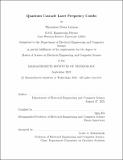Quantum Cascade Laser Frequency Combs
Author(s)
Letsou, Theodore Peter
DownloadThesis PDF (11.17Mb)
Advisor
Hu, Qing
Terms of use
Metadata
Show full item recordAbstract
Quantum cascade lasers (QCLs) have been the dominant source of high-power infrared radiation ever since their invention in 1994. The ability to engineer their emission wavelengths from 3 𝜇m to 300 𝜇m has allowed scientists to use QCLs in a plethora of applications, ranging from spectroscopy to tomography. In addition, QCLs are highly non-linear devices, and possess the ability to emit many frequencies of light simultaneously. This has made them excellent candidates for frequency combs, which are broadband light sources that emit equally-spaced frequencies with a well-defined phase relation. By manipulating the optical non-linearities through dispersion engineering, QCLs can be made to enter frequency combs states on-demand. By mixing two different frequency combs, absorption features at optically frequencies can be encoded into the radio-frequency domain, eliminating the need for expensive, high-frequency detectors. This "dual-comb spectrometer" offers a chip-scale alternative to bulky spectrometers, making it one of the most attractive applications of QCLs.
This thesis outlines the development, characterization and theory of QCL frequency combs operating in the atmospheric transmission window (8 𝜇m – 12 𝜇m)—a spectral region where many chemical species have their fundamental vibrational and absorption bands. By borrowing techniques commonly used in ultra-fast optics, the dispersion of QCLs—which is the primary catalyst for comb formation—can be tuned without the use of mechanically-moving parts. In addition, this thesis utilizes optical coherence techniques to reconstruct the electric field profile of QCL combs, which provides valuable insight on the physics of their formation.
Date issued
2021-09Department
Massachusetts Institute of Technology. Department of Electrical Engineering and Computer SciencePublisher
Massachusetts Institute of Technology